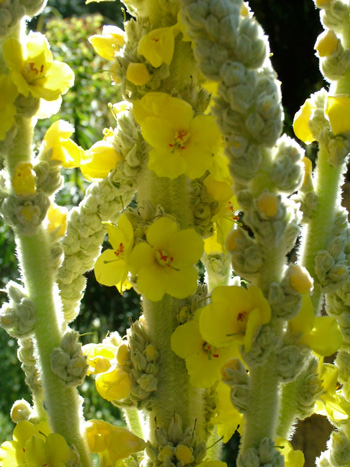Cultivating Shrubs and Trees with Bambi

There should never be a book for a national readership on deer resistant plants.
One of the greatest lessons deer have to teach us is that nature is far more dynamic than we often acknowledge. Deer are capable of constantly adapting, and over a decade's time, dozens of plants that were once deer-resistant will have become palatable or even preferred salad-bar options—count on it. Consequently, the only realistic deer-tolerant landscape is one which is partially redesigned and replanted almost every year, and a good designer is always testing new plants to find replacements for those being added to bambi's menu.
Here are some very rudimentary guidelines for deer-resistant plant material, based on specific plant examples from my home landscape (which, however, may or may not work with your deer.)
• The first guideline is that there are no concrete guidelines. For instance, the same species of white-tailed deer will eat very different plants from state to state, city to city and even in different areas of the same county. For all practical purposes, there are hundreds of sub-species or "clonal herds" which have developed their own diets. So, get to know very well what your local deer eat; no "official" list will match your reality.
• There are almost no "deer proof" plants; any plant will be damaged if a 200-lb. mammal lies on it or uses it to preen its antlers. Even plants not usually on the menu may be nibbled at in a hungry year, so deer-resistant plants are a more reasonable goal. Over a period of seven years in my landscape, some completely uneaten plants include: all varieties of rosemary (Rosmarinus spp.), all species of santolina (Santolina spp.) (choice mattresses, however, for sleeping and resting deer), all lavenders (Lavandula spp.) And Jerusalem sage (Phlomis fruticosa).
• Higher deer populations greatly increase the number of plant species that deer will devour. Since most urban/suburban deer herds are continuing to increase, count on designing for the worst-case scenario—and an ever-dwindling repertoire of tried-and-true plants. Until three years ago, the lily-of-the-Nile (Agapanthus africanus) in my landscape was safe from hungry ungulates; now its buds are regular midsummer fodder. Forty miles south of my house, this plant lost its deer-resistance ten years ago.
• Exotic, non-native plants are usually less ravaged than native varieties, possibly because the deer haven't evolved with these plants and so learned to tolerate or digest their matrix of chemicals, toxins and fibers. One particularly deer-tolerant group of exotic plants for my area are the Australian grevilleas: Grevillea lavandulacea, G. 'Canberra,' G. rosmarinifolia, G. 'Noelii,' and G. lanigera.
• Thorns are no guarantee of protection. Rose plants, covered with big or little thorns, are preferred deer forage throughout the country. Only certain thickly-thorned cactus are deer- (and people-) resistant.
• Silver, gray or glaucous foliage is not a sure indicator of deer-resistance. Witness the dusty miller (Senecio cineraria), wormwood (Artemesia absinthium) and matilija poppy (Romneya coulteri) plants I've lost from my test plot. However, pride of Madeira (Echium fastuosum), woolly thyme (Thymus pseudolanuginosus) and santolina (Santolina chamaecyparissus) all have gray foliage as well as reasonable to high deer-resistance.
• Plants of the same genus aren't necessarily equal in their deer-resistance factors. The deer have never eaten my common culinary thyme (Thymus vulgaris) or the lemon-scented Thymus citriodorus, but after August, when the native California landscape is dry and crusty, they'll feast on well-watered woolly thyme grown in a container. The resistance or palatability factor is highly variable between species and named varieties of wild lilacs (Ceanothus spp.) Ceanothus 'Julia Phelps' isn't eaten, but seems to be a favorite for antler-rubbing, leaving many torn limbs and stripped bark.
|
 |
• Prostrate growth habit is no guarantee of protection from these so-called browsers. Prostrate plants which have been eaten at my house include: 3-4-inch-tall Ceanothus hearstiorum (but only in late summer, after blooming), ornamental strawberry (Fragaria spp., is a favorite) and bearberry or prostrate manzanita (Arctostaphylos uva-ursi), a native 2-4 inches high).
• Never count on aromatic herbs to be deer proof. Notable aromatics favored by grazing deer include: sweet marjoram (Origanum majorana), mints (many members of the mentha genus), garlic chives (Allium tuberosum—good until four years ago, now a regular late-summer snack), basil (Ocimum spp.) And bronze fennel (Foeniculum vulgare dulcee, var. Rubrum). Beside the herbs mentioned earlier in the article, I've had success with some sages (Salvia officinalis, S. clevelandii and S. leucophylla).
• Bulbs and tuberous-rooted plants are hit-and-miss. Narcissus, daffodil, native Douglas iris (Iris douglasiana), Dutch iris and hyacinth blooms are reliably deer proof, but the hoofed connoisseurs eventually seem to learn to love tulip flowers. Old-fashioned daylilies (Hemerocallis fulva) are often ignored, but the flower buds on hybrid daylilies are often eaten before they open.
When purchasing plants for native California landscapes, I try to avoid those which are well-fed and amply-watered. Deer love to feast on the succulent new growth found on lush nursery plants. As a result, I prefer "crusty," woody and under grown plant material for deerscapes. Before planting over stimulated nursery plants at a deer-plagued job site, I take them to a fenced area near my house for a few weeks' hardening off by means of reduced watering and skipping all fertilizers

Mullien is a deer-resistant biennial in my garden.
Any transplant, by virtue of the water necessarily added at planting, is vulnerable for the first few weeks or more. When installing plants that are marginally deer-resistant, or where the deer population is high, use a deer-repellent spray. University-sponsored tests have shown the best sprays to contain either rotten (fermented) egg solids, ammonia and fatty acid soaps, or Thiram™ (a chemical repellent) as the primary ingredient. Hot red-pepper and Tabasco™ sprays have a strong reputation, but they don't always measure up in controlled field and orchard trials. A contractor using them should spray the entire foliage and some of the mulch around each new plant before leaving the job site each day. Warning: if mixed too strongly, all of these sprays may burn the foliage of well-fed and heavily-watered plants.; read the labels, and use hardened-off plants where possible.
Designing for a landscape which can coexist with deer is a constant learning process for the landscape architect. The best deer-resistant landscapes are often designed by very local landscape architects, not out-of-towners. And, since deer are busily adapting even at this very moment, no designer can rest long on his/her laurels. From observing how deer interact with landscapes, we can learn much about the persistent flux and adaptability of nature. These wily ungulates can teach designers to work with native realities, rather than the latest sustainable-growth theory or environmental paradigm. Not bad for a "dumb" animal!.
Let me know what you think! Email me at rkourik@sonic.net
** Read my "Longbit" about Beneficial Insects and Companion Planting.
Read Previous Tidbits in our Archive:
• Shovels and spades
• Foxgloves
• Mixing the Horticultural Interlopers with the Natives
• Drip irrigation
• Kiwis
• Pruning tools and paraphernalia
• Cultivating Shrubs and Trees with Bambi
• Caterpillars are pests aren't they?
• Peasant Gardens versus Convenience
• Planting a Tree
• Parallel Drip In-Line Emitter Tubing
• Trees that Heave Patios & Walkways
• Succulent Asian Pears
• Wacky Garden Myths
• Winter Pruning
• In-line Drip Emitter
• Super Sturdy Pressure Regulator
• Myth: Taproots Anchor All Trees
• Composting
• Soil Biota and Moisture
• Off Season Beauty
• Cistern Water for Landscapes
• Double Digging vs. No-Till Method
• Parabolic Windbreaks
• The Limits of Diversity
• Gophers
• Grey Water
• Microbial and Fungal Inoculants
• Non-Leguminous Nitrogen Fixers
• Soil Amendments
• In-Line Drip Irrigation
• Friendly Fungus
• Fungus Benefits for Plants
• Summer Pruning
• What's Ornamental?
• Deep Watering for Survival Only
|

